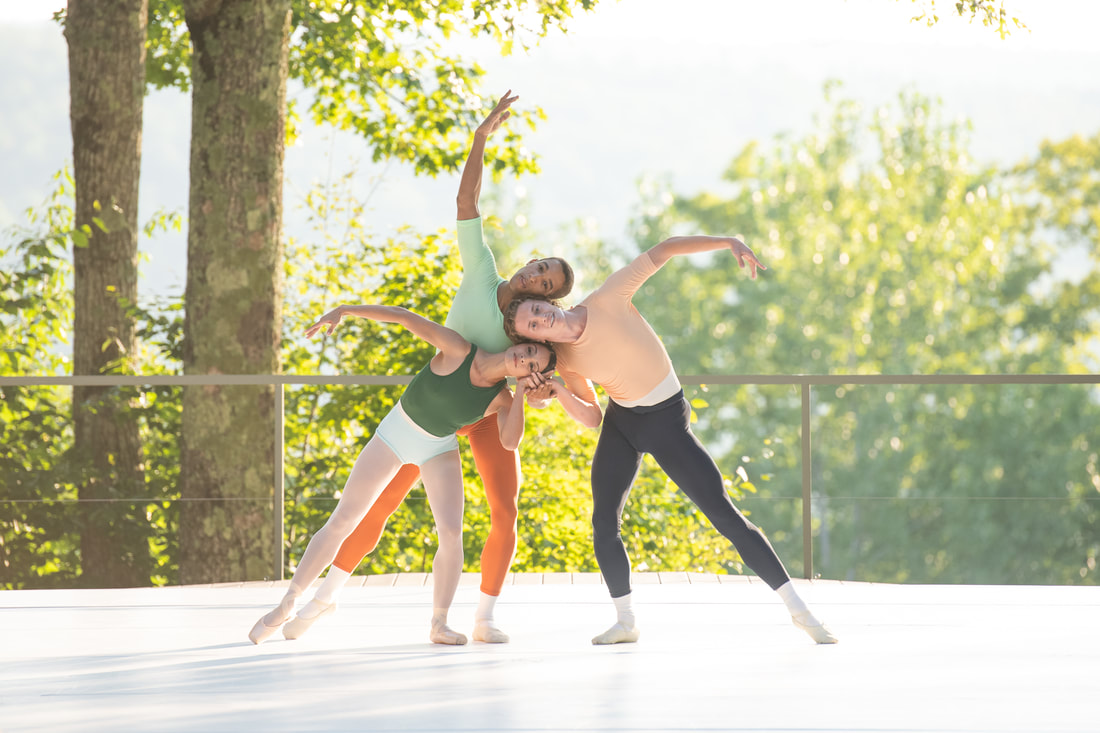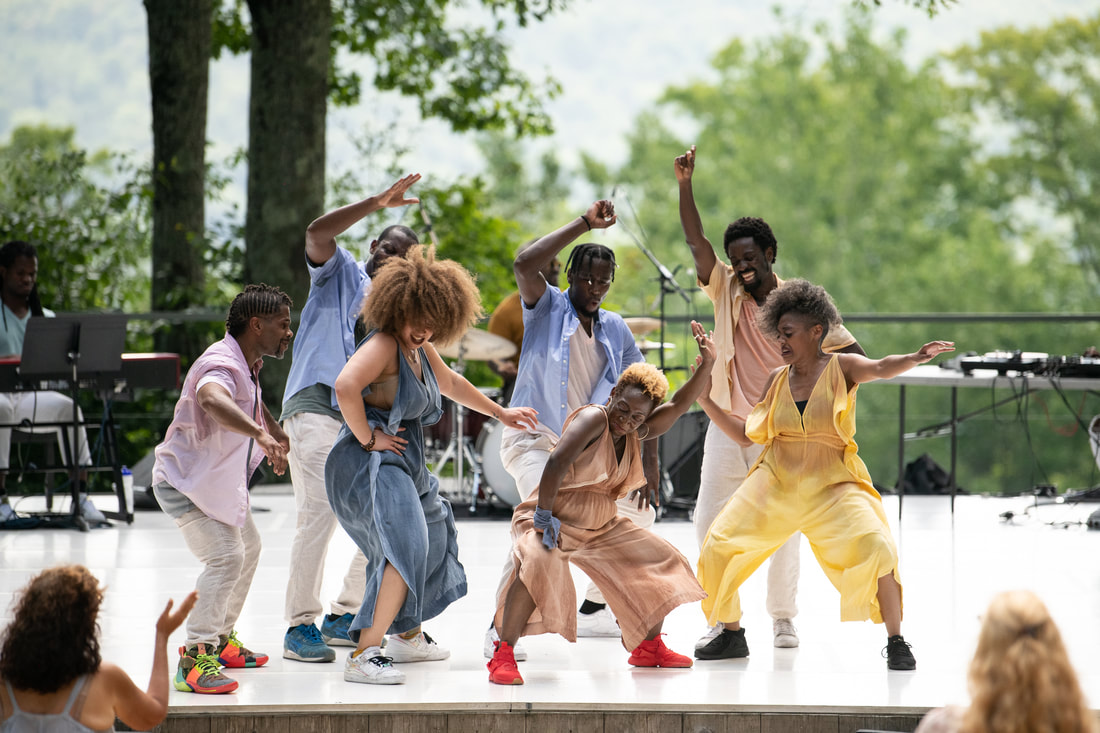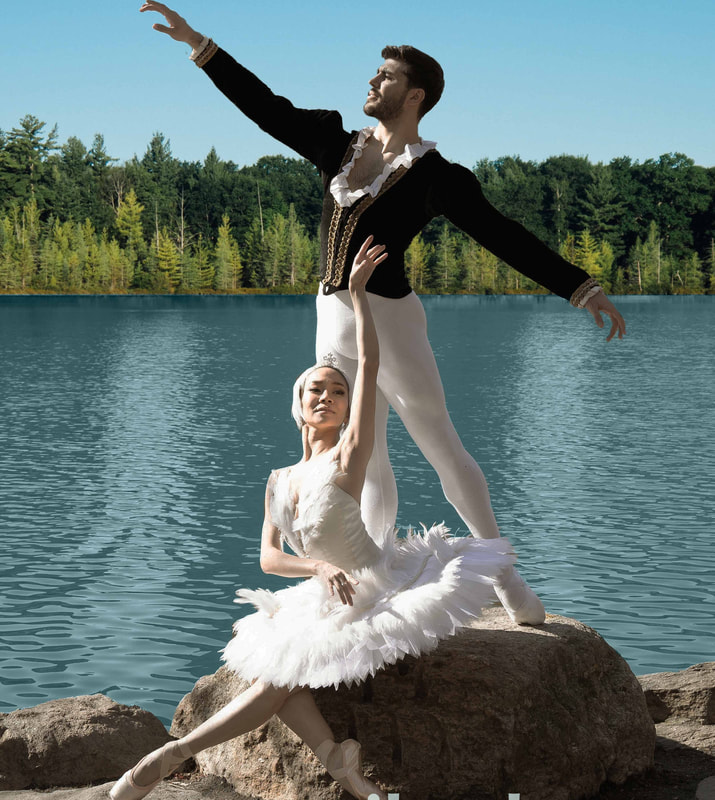|
Houston Ballet dancers Karina Gonzalez, Harper Watters and Chandler Dalton dance in Justin Peck's "Reflections," a ballet that premiered just days before the pandemic shutdown theaters. (Photo by Christopher Duggan) Many of us will remember this summer as the great reunion – a return to places we love with people we love.
Among the great reunions is that of the ballet dancer with the stage. For months during the pandemic, they toiled in living rooms and kitchens trying to maintain their strength and technique. At Jacob’s Pillow this week, sadly the last for the 2021 festival, ballet dancers from around the country prove their efforts at home were not in vain. Not only did they show they can endure, but also grow as artists. That is clear in a thoughtful program with dancers from three major companies – Boston Ballet, Houston Ballet and Pacific Northwest Ballet – on the outdoor stage. Going under the moniker of Ballet Coast to Coast, the group presented five short works that ensure audiences that ballet’s evocative beauty, despite the pandemic, continues to be relevant. Being a balletomane, I must say this was one of my favorite programs of the summer. But beyond ballet, it’s the fact that the dancers aren’t showing off an individual prowess (something we saw a lot this summer at the Pillow). Instead they are relating how their unity with and sensitivity toward each other creates something that resonates. Most impressive was Houston’s Harper Watters and Karina Gonzalez in Stanton Welch’s “Sons de L’Ame.” To music by Chopin, the piece begins to a waltz with Watters who is sheer perfection. Watters becomes the Slavic-flavored music with his exquisite lines, balances and turns. And then Gonzalez appears and the two melt into each other to a Chopin nocturne in a way this is both gentle but shimmering. These two have a rapport is unique and sends the work – that might seem banal on other dancers – to its zenith. The program also featured a world premiere by Helen Pickett for a trio of dancers from Boston Ballet. The piece reflects life at home – it’s highs and lows – with floppy boredom and burst of silliness playing a part. While cute and showed off the dancers – the supple Lia Ciro with Paul Craig and My’Kal Stromile – well, it’s a curiosity for its time. Disappointing was Justin Peck’s “Reflections,” also danced by Houston Ballet. To music by Sufjian Stevens, the piece demonstrates Peck’s ability to move dancers into configuration that always surprise. However, “Reflections” loses something in the staging, which happens often in the stripped down Pillow stagings outdoors. Certainly, that is the case with Ulysses Dove’s “Red Angels,” performed by a Pacific Northwest quartet. Still the ballet, to Richard Einhorn’s “Maxwell’s Demon,” startles with dancers in red, taking flight like warriors in the battle for good and evil. It remains powerful. The program’s finale is also potent – Alejandro Cerruda’s gorgeous “Second to Last” to music by Avro Part. In a series of duets for all of the Coast to Coast dancers, Cerruda’s succulent suite seems to mark the minutes of the pandemic in the most sobering terms. Its message: every moment is precious, so love fully. Ballet Coast to Coast runs through Sunday at Jacob’s Pillow.
0 Comments
From left, Duane Lee Holland Jr., Ray F. Davis, Reyna Núñez, Tyedric Hill, LaTasha Barnes, Alaine Lauture and Shana Maria Weaver perform in LaTasha Barnes' "The Jazz Continuum." (Photo by Cherylynn Tsushima) Having a dance party? Then you need to invite Latasha Barnes and her crew.
Performing this week at Jacob’s Pillow, this ensemble of dancers and musicians, including DJ Britney Brown, had the outdoor stage at the historic dance venue bouncing (literally) to “The Jazz Continuum.” This work is infectiously upbeat, yeasty brew that has audiences swaying and clapping. But it is also scholarly for its ability to show audience the evolution of social dance forged in the Black community. From traditional African to jazz to lindy to house to waacking, there is a connection and audience can see it for themselves in the work that plays through Sunday. The thing that makes “Jazz Continuum” so invigorating for dancers and audience is the emphasis on social. It’s about having fun with others – not about being a refined, synchronized ensemble. In six indistinguishable sections called “Explorations,” Barnes and six other dancers are drawn together – in choreographed circles and lines that give way for the individual to emerge. Shana Maria Weaver offers a simmering solo. Slow and low to the ground, she draws out the saxophone (played by Christopher McBride). Together, they meld in a way that music and dance should always bond, symbiotically. Reyna Nunez is the queen of sultry waacking, Duane Lee Holland Jr. punctuates his fancy footwork with cartwheels and flips while Alaine Lauture and Tyedric Hill are towers of the coolest house moves. Barnes, a spitfire, is pure joy to watch. Dancing with a bright smile that never fades, she surprises with her ability to embody all styles with optimism. One could watch her all day because she radiates hope for the world. Together or separate, the dancers and musicians do it all with a touch that is light and playful. They banter as they move, demonstrating an honest and respectful rapport. Moreover, Barnes and her dancers, with a gestural embrace to the heavens, acknowledge all those who have gone before them – creating the dance they enjoy and embellish today. Thus, Barnes gives her party some spiritual and intellectual depth. Barnes and troupe enhance an already amazing season at the Pillow. Since the pandemic, the dance haven has transformed to accommodate artists and audiences safely by keeping it all outdoors. But the artistic choices have also been broader, embracing dance styles not often seen on the formal stages at the venue where mostly white artists perform. Thank you Jacob’s Pillow for creating this oasis for all dance and dancers. Momoko Burbine danced Odette/Odile and Klevis Tafaj portrayed Prince Siegfried in Ajkun Ballet Theatre's condensed "Swan Lake" at The Egg. The region’s performing arts saw two triumphs on Saturday night.
1. The Egg, Albany’s premiere stage, reopened with its first show since March 2020. 2. Ajkun Ballet performed “Swan Lake” beautifully there. The first, of course, offers a glimmer of what is to come – theaters opened with masked and socially distanced patrons – even with the pandemic still raging. The second is amazing as the Ajkun Ballet Theatre often doesn’t perform well – appearing as a ragtag group of dancers of all abilities whom its Artistic Director Chiara Ajkun tires to shape into a scintillating, cohesive classical ballet ensemble. The company performs every summer at The Egg, with 2020 as the exception. When I saw the company on the calendar for Saturday, I was skeptical, but felt an obligation to go. Allowing myself to only go to the shows I know have promise isn’t fair to me or my few readers. But as soon as Momoko Burbine stepped on stage as Odette/Odile, the enchanted swan who seeks true love from the capricious Prince Siegfried, I was the one enchanted. She was a near perfect Odette/Odile, the most challenging role that any ballerina dances as she must play two characters – the sweet, fearful Odette and the evil, scheming Odile. As Odette, Burbine was delicate – the flutter of her foot as Siegfried, danced by Klevis Tafaj, twirled her, spoke of her fragility. This tiny dancer melted and swooned into the Tafaj who lifted her with tenderness and ease. And of course the provocative and lush Tchaikovsky score ramped up the impassioned emotion. They convinced the audience that the bond they sealed at the lake could not be severed. Of course, we were wrong. As Odile, Burbine transformed – she was sharp with a plastered sinister smile. (That was not necessary and a little distracting.) She also faltered on the ballet’s most steely technical test – the 32 fouettes. I counted 25 rotations of the leg-whipping step. That’s ok because even top ballerina struggle with that. And all was forgiven as she returned to as the desperate Odette who realizes Siegfried betrayed her with Odile. Burbine was not the only amazing dancer. Telmen Munkherdene as the Jester was also superb. As Siegfried’s entertainer and confidant, he was a whirling, leaping marvel who was a pleasure to watch every time he took the stage. Because there was no intermission, which seems to be a COVID-19 precaution at all the theaters, Ajkun trimmed down the ballet to the essential storytelling segments – without the incidental dancing. She did, happily, preserve the divertissements at the ball. But condensing the ballet required chopping up the score, which at times was jarring. Also annoying was the continuous mid-ballet bows, cutting off the action and the magic. It’s old-fashioned, a relic from the days when Russia was king of the artform, and unsettling for American audiences who feel forced to applaud. Also, I’m not thrilled with Ajkun’s ending. “Swan Lake” is ballet’s great tragedy, on par with “Romeo and Juliet.” But Ajkun gave it a happy ending with Siegfried killing the sorcerer, freeing Odette. Thus the two live happily ever after. The tragic ending, though sad, provides resonance that the sweet finale simply can’t. While the bowing and the ending need to go, the dancing, especially that of Burbine, lives on. |
Wendy
|



 RSS Feed
RSS Feed
